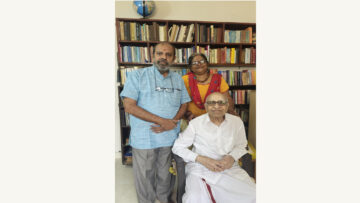I. Introduction: The Two Rivers of Bhakti and Jñāna
The Varkari tradition of Maharashtra is often pictured as a bhakti outpouring—ecstatic singing, mass pilgrimage, saint-poets pouring love into vernacular verse. But beneath the familiar rhythms of abhaṅgas, the saffron flags, and the dusty vāri marches to Paṇḍharpur runs a subtler current: a yogic discipline of inner transformation.
When read through the lens of jñāna-yoga, the Varkari path reveals itself as a vernacular technology of the Self—a way of unhooking the mind from its compulsions, refining perception, and stabilizing attention in the formless ground of awareness. What is striking is that these transformations happen not in solitary hermitages but in crowds, on roads, in kitchens, in the sung and danced Name of Viṭṭhala.
From the standpoint of modern cognitive theology and Western philosophy of mind, this is a fascinating case: an embodied, social practice that accomplishes what Patañjali’s Yoga Sūtra prescribes—citta-vṛtti-nirodha (stilling the modifications of mind)—by means of community ritual, sensory saturation, and emotional devotion. The Varkari path’s jñāna is not bookish but embodied; its “laboratory” is the street, its “methods” are kīrtana, pilgrimage, service, and name-chanting.
In this essay, we will examine how Varkari jñāna-yoga works as a cognitive technology, exploring its mechanisms through:
- Divination: ways of making the invisible visible to the mind.
- Embodiment: using bodily states to alter cognitive states.
- Sensory Awakening: harnessing sound, rhythm, color, and space to shift consciousness.
- Cognitive Awakening: restructuring beliefs, self-models, and attentional patterns.
We will then contrast these mechanisms with the Yoga Sūtra’s map of inner ascent toward samādhi, arguing that Varkari practice—while clothed in bhakti—quietly follows the same deep architecture of mind-transformation that Patañjali outlines.
II. The Cognitive Ground of Varkari Jñāna-Yoga
1. The Saints as Cognitive Guides
The Varkari lineage is defined not by a founder but by a sequence of saints—Jñāneśvar, Nāmdev, Eknāth, Tukārām—who serve as cognitive templates. Each saint is both a model and a transmitter of ways of seeing:
- Jñāneśvar: transforms Advaita metaphysics into experiential metaphors in Marathi. He demonstrates that understanding is not mere intellectual grasp but anubhava—direct tasting of truth.
- Nāmdev: embodies constant God-awareness in mundane life, modeling attentional training through name-repetition.
- Eknāth: integrates jñāna with ethics, showing that discernment (viveka) is inseparable from compassion.
- Tukārām: wields poetry as a razor to cut through self-delusion, modeling self-observation and ego-dismantling.
From a cognitive standpoint, these saints provide narrative schemas—ways of organizing perception and interpreting experience—that are internalized through repeated hearing, singing, and enactment.
2. Jñāna in the Vernacular
The Jñāneśvarī and Amṛtānubhava show a distinctive jñāna pedagogy: abstract concepts are translated into image-rich metaphors (“space in a pot,” “salt in water”), which cognitive linguistics recognizes as embodied metaphors—mappings from sensorimotor experience to abstract domains. This means that philosophical insight is encoded in bodily and sensory terms, making it accessible to procedural memory (doing) as well as declarative memory (knowing).
Such imagery is not ornamental—it is the method. By repeatedly activating these embodied schemas in kīrtana and abhaṅga, Varkari practitioners reinforce the neural networks that allow for non-dual recognition to become second nature.
III. Divination: Making the Invisible Visible
In the Varkari frame, divination is not fortune-telling but the cognitive act of reading the signs of the Real in the flux of the everyday. Viṭṭhala’s form on the brick is itself a kind of divine “sign”—an index pointing beyond itself.
1. Pilgrimage as Divinatory Movement
The vāri is an enactment of a cosmic truth: the journey to Paṇḍharpur is the journey inward. Walking becomes a moving mandala; each step is a repetition of the Name; each town passed is an inner threshold crossed. The physical path divines the invisible path.
Cognitive scientists of ritual (Harvey Whitehouse, Pascal Boyer) note that repetitive, high-arousal rituals create shared representations that are remembered with exceptional vividness. The Varkari pilgrim, without realizing it, is inscribing a spatial metaphor (“life is a journey to God”) deep into autobiographical memory. This is a form of narrative divination—mapping an inner state onto outer movement and then reading the movement back as guidance.
2. Saints’ Lives as Oracles
The pālakhi processions carry the sandals of saints, but also carry their stories. These narratives are treated as mirrors in which pilgrims see their own condition. A line from Tukārām may appear “by chance” in a kīrtana and answer a pilgrim’s unspoken doubt. In cognitive terms, this is pattern completion: the mind matches an ambiguous stimulus (a verse) with a personally salient question, creating the sense of a “message.”
This is structurally similar to divination systems (e.g., the I Ching, Tarot) in the West, where random or semi-random inputs are interpreted in context. The randomness allows the unconscious to project, making latent concerns visible.
IV. Embodiment: Training the Mind Through the Body
Western cognitive science increasingly recognizes what Indian traditions have long assumed: the mind is not confined to the skull; it is distributed through the body and environment. Varkari practice exploits this in multiple ways.
1. The Walking Body
Walking long distances in rhythm with chanting induces entrainment—synchronization of bodily rhythms with external rhythms—which affects neural oscillations and attention. Over days, the combination of exertion, repetitive chant, and reduced sensory novelty can produce altered states akin to the dhāraṇā (concentration) stage of Patañjali’s eight limbs.
2. Dietary and Ethical Disciplines
The Ekādaśī fasts and the avoidance of meat, intoxicants, and excess during the vāri are not merely moral gestures—they alter physiology. Fasting shifts metabolism, affecting neurochemistry and mood; abstention from certain foods and behaviors reduces fluctuations in arousal, stabilizing attention.
The yamas (non-violence, truth, non-stealing, celibacy, non-possessiveness) and niyamas (purity, contentment, discipline, self-study, surrender) in the Yoga Sūtra work the same way: they remove gross disturbances to the mind-body system, making meditative states more accessible.
3. Gesture and Posture
Holding the saffron flag, clapping in rhythm, bowing before the deity—these are micro-postural cues that reinforce emotional states. Neuroscience calls this “embodied emotion”—where adopting a physical expression feeds back into mood. A bowed head strengthens humility; an open chest in song can evoke joy and expansiveness. Over years, these postures become default somatic patterns, supporting the inner stance of devotion and witness-consciousness.
V. Sensory and Cognitive Awakening
1. Sound as Cognitive Tool
Nāma-smaraṇa (name-repetition) is an auditory mantra practice. In both Indic and Western contemplative psychology, repetitive sound narrows attentional bandwidth, reducing mental chatter. The sonic form of “Vithoba” or “Rām-Kṛṣṇa-Hari” becomes a perceptual anchor, a safe “home base” for attention.
From a Yogasūtra perspective, this is japa (YS 1.28), leading to tajjapaḥ tadartha-bhāvanam—repetition with reflection on its meaning—culminating in the quieting of the mind.
2. Color, Image, and Spatial Memory
The saffron flags, the brick under Viṭṭhala’s feet, the vivid saris and turbans—these visual constants become mnemonic icons. The brain’s visual memory systems tag these images with emotional salience; recalling them evokes the associated devotional states. This is why the darshan (sighting) of Viṭṭhala in the sanctum is climactic: it imprints a sensory snapshot as a touchstone for meditation.
3. Narrative as Cognitive Schema
Western narrative theology (e.g., Paul Ricoeur, Hans Frei) suggests that repeated exposure to a sacred story reshapes the believer’s emplotment—how they plot their own life’s events. In Varkari life, the Gītā as retold by Jñāneśvar, the legends of Puṇḍalika, and the saints’ poems become the story-architecture of perception. Cognitive psychologists would call this “schema theory”: once a schema is in place, new experiences are interpreted in its light.
VI. Cognitive Awakening: Restructuring the Self
1. Witness-Consciousness through Bhakti
In Patañjali’s model, the move toward samādhi involves cultivating the draṣṭṛ—the seer—distinct from the seen. Varkari bhakti does this via relational language: “I am Yours; You are the doer; I am but Your servant.” By transferring agency to Viṭṭhala, the practitioner experiences a decentering of the ego. This functional surrender is structurally similar to the neti neti method of Advaita: both detach identification from the stream of mental events.
2. Emotional Regulation via the Name
Modern affective neuroscience sees mantra repetition as a form of affect labeling—a technique that engages prefrontal control over limbic reactivity. In practice, a Varkari who responds to stress by chanting the name of Vitthala interrupts the habitual fight-flight pattern, creating space for reflective awareness.
3. The Role of Joy
Western accounts of mystical cognition often underplay joy, focusing on solemn contemplation. Varkari practice, however, uses collective joy as a cognitive lubricant: synchronized singing releases dopamine and oxytocin, enhancing social bonding and motivation. These neurochemical shifts lower the perceived effort of attentional training, making long-term practice sustainable.
VII. Varkari Practice and the Yoga Sūtra’s Inner Map
The Yoga Sūtra lays out an eightfold (aṣṭāṅga) path:
- Yama – Ethical restraints
- Niyama – Personal observances
- Āsana – Posture
- Prāṇāyāma – Breath regulation
- Pratyāhāra – Withdrawal of senses
- Dhāraṇā – Concentration
- Dhyāna – Meditation
- Samādhi – Absorption
While the Varkari tradition does not frame itself in these terms, its practices map remarkably well:
- Yama/Niyama: Pilgrim codes of conduct (truthfulness, non-injury, celibacy during vāri, humility, service).
- Āsana: No fixed postures, but the act of walking becomes a dynamic āsana—a stable seat of awareness in motion.
- Prāṇāyāma: Chanting regulates breath automatically; many abhaṅgas are composed in meters that synchronize with slow, deep breathing.
- Pratyāhāra: The sensory field is simplified during pilgrimage—same sights, sounds, and actions daily—reducing distraction and turning senses inward toward the Name.
- Dhāraṇā: Focusing on Viṭṭhala’s image or the Name trains single-pointedness.
- Dhyāna: Extended singing and remembrance induce effortless meditation, where attention rests on the beloved without strain.
- Samādhi: In moments of deep absorption—sometimes during dindi singing, sometimes in the sanctum—the sense of self-other collapses. Devotees may describe it as “Viṭṭhala alone remains,” a direct parallel to the non-dual absorption of nirbīja samādhi.
VIII. Contrasts and Convergences
1. Explicit vs. Implicit Systems
Patañjali offers an explicit, technical manual. The Varkari path offers an implicit, narrative-based curriculum. But the cognitive sequence is similar: ethical and sensory preparation → focused attention → sustained contemplation → self-transcendence.
2. Solitary vs. Social
Classical Yoga often imagines solitary practice; Varkari discipline is radically social. Yet recent cognitive science confirms that social synchrony can accelerate learning and state induction. In this sense, the Varkari “crowd” functions as a collective nervous system, scaffolding each individual’s inward turn.
3. Emotion in the Path
Where Patañjali treats emotion mostly as a source of disturbance (kleśa), the Varkari tradition uses devotion’s emotional charge as fuel for the ascent. Modern affective science supports this: emotionally salient practice has higher adherence and deeper memory traces.
IX. Conclusion: A Yogic Science in Pilgrim’s Clothing
To watch a dindi of Varkari pilgrims is to see philosophy in motion: bodies aligned in rhythm, voices bound in unison, minds tethered to a single Name. The external spectacle hides an internal precision: ethical restraint, breath regulation through chant, sensory simplification, attention training, ego-decentering, and—at moments—absorption into a non-dual field of awareness.
From the standpoint of Western cognitive theology, the Varkari path is a “distributed contemplative system”: the individual’s cognitive transformation is scaffolded by narrative, ritual, community, and environment. From the standpoint of the Yoga Sūtra, it is an alternative delivery system for the same inner project—samādhi as self-realization.
The endpoint is the same: the stilling of mental fluctuations, the recognition of consciousness as one’s true nature, the easeful stance of the standing God—patient, unshaken, fully present.
Feature Image Credit: istockphoto.com
Disclaimer: The opinions expressed in this article belong to the author. Indic Today is neither responsible nor liable for the accuracy, completeness, suitability, or validity of any information in the article.








